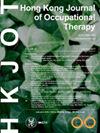马来语标准版普渡钉板测验:内容效度与重测信度检验
IF 1.6
4区 医学
Q4 REHABILITATION
引用次数: 1
摘要
普渡钉板测试(PPT)是一种有效和可靠的仪器,用于测量个人的手灵巧性有或没有医疗条件。在广泛使用马来语的东南亚地区,普渡钉板测试需要有马来语翻译。本研究旨在将PPT翻译成马来语版本(PPT- m),并确定该翻译版本的内容效度和重测信度。方法本研究涉及:(1)四名英语教师(译者)进行正向和反向翻译程序;(2) 10名职业治疗领域专家(专家评审)进行内容效度检验;(3) 60名本科生(被试)进行重测信度检验。结果PPT-M具有较好的内容效度,项目-内容效度指数为0.9 ~ 1.0,量表-内容效度指数/平均值为0.93 ~ 0.95,量表-内容效度指数/普遍一致性指数为0.25 ~ 0.75。3次试验给药的重测信度(n = 30;类内相关系数,ICCs = 0.76-0.85;良好)比单期给药(n = 30;icc = 0.34-0.46;对所有子测试来说都很差。两种试验管理主要受系统错误的影响,特别是练习效应,因为复试得分较高。随机误差主要影响1次给药的子测试3,其最小可检测变化百分比值= 30.84%超出了可接受范围。结论pt - m有潜力成为测量马来语个体手灵巧度的有价值的工具,特别是当使用3次试验给药时。本文章由计算机程序翻译,如有差异,请以英文原文为准。
The standardised malay version of purdue pegboard test: Content validity and test-retest reliability testing
Introduction Purdue Pegboard Test (PPT) is a valid and reliable instrument for measuring hand dexterity among individuals with or without medical conditions. In the Southeast Asia region where Malay is widely spoken, there is a need to have a Malay translation of Purdue Pegboard Test. This study aimed to translate the PPT into the Malay version (PPT-M) and to determine the content validity and test-retest reliability of this translated version. Methods This study involved: (1) four English teachers (translators) for forward and backward translation procedures; (2) 10 experts in the field of occupational therapy (expert reviewers) for content validity testing; and (3) 60 undergraduate students (participants) for test-retest reliability testing. Results PPT-M had excellent content validity with Item-Content Validity Index = 0.9–1.0, Scale-Content Validity Index/Average = 0.93–0.95, and a slightly lower Scale-Content Validity Index/Universal Agreement = 0.25–0.75. Test-retest reliability for 3-trial administration ( n = 30; Intraclass Correlation Coefficients, ICCs = 0.76–0.85; good) was higher compared to 1-trial administration ( n = 30; ICCs = 0.34–0.46; poor) for all subtests. Both trial administrations were mostly affected by systematic errors, especially practice effect as the retests gave higher scores. Random errors mostly affected Subtest 3 of 1-trial administration, evident by its Minimal Detectable Change Percent values = 30.84% that fell beyond the acceptable range. Conclusion PPT-M has the potential to be a valuable instrument for measuring hand dexterity among Malay speaking individuals especially when the 3-trial administration is used.
求助全文
通过发布文献求助,成功后即可免费获取论文全文。
去求助
来源期刊
CiteScore
1.10
自引率
0.00%
发文量
18
审稿时长
>12 weeks
期刊介绍:
The Hong Kong Journal of Occupational Therapy is the official peer-reviewed open access publication of the Hong Kong Occupational Therapy Association. The Journal aims to promote the development of theory and practice in occupational therapy (OT), and facilitate documentation and communication among educators, researchers and practitioners. It also works to advance availability, use, support and excellence of OT and maintain professional standards to promote better understanding of OT.

 求助内容:
求助内容: 应助结果提醒方式:
应助结果提醒方式:


